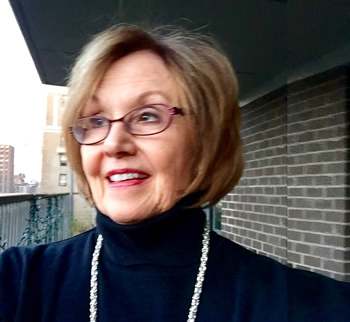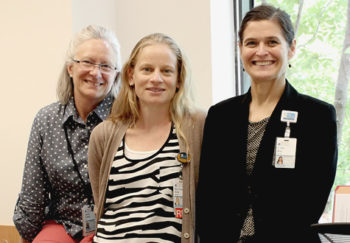
Most people would not expect their doctor to prescribe yoga for high blood pressure.
But then, most people would find everything about Sandra Lowe unexpected.
At 78, Sandra looks decades younger. The picture of health, she’s been exercising since the 1960s. From Jazzercise to aerobic dancing, Jane Fonda and Richard Simmons, to even running and winning an 8K, Sandra’s never stopped moving. Dedicated for more than a decade to a daily yoga practice (“life-changing!”), she proudly tells me she’s not, unlike most of her peers, on any medications.
One would never expect Sandra, of all people, to have high blood pressure.
A Surprise Spike of Blood Pressure
She was surprised, too. At a routine appointment last summer, she experienced an unusual, frightening episode of hypertension. “I didn’t even know I had elevated blood pressure. It spiked!”
Her primary care doctor at the time followed the same path most providers do: Prescribed Sandra medication to lower her blood pressure.
But Sandra suspected that the issue wasn’t medical, but emotional, due to a family crisis that had been happening. “You get spread thin, you try to fix things, and sometimes you can’t fix things; so you internalize it and you get sick. I thought, ‘I have to stop this.’” She knew she needed to address her stress levels.
Still, being a “compliant patient,” she took the prescription. But then she had a reaction. “I called the doctor and asked, ‘Is there something else we can do?’ The guy said, ‘We’ll prescribe another medication.’ But I looked it up and saw it was the same thing, with the same ingredients that I’d reacted to. I wasn’t asked to come in or to have another exam; just ‘call us if you feel worse.’ That was not what I expect in a physician’s care. Perhaps that’s unrealistic, but I expected more.”
Sandra wanted to be listened to.
“All my life I had mostly male patronizing doctors,” she says. “When I went through menopause and questioned using estrogen, I was told, ‘Sweetie, all my little ladies take estrogen; don’t worry about it.’
“Remarks like that, being treated like another species that has to be herded? I’ve had to put up with that all these years.”
Whole Person Healthcare: A Beautiful, Comfortable Space
Sandra started looking for “healthcare where they look at the total person.” She spent days researching online, watched a video with Denise Way, MD, and then spoke in depth with John Leiner, MD, of the UVA Primary and Specialty Care Pantops clinic. Sandra told Leiner, “I practice yoga, and I don’t want to take medicine.” Leiner was amenable, so she called and got an immediate appointment.
The space at the clinic made a big impression on Sandra.
She found “physical things to make a patient more comfortable. It’s bright, with live plants, and beautiful.”
From the front office staff to the nurses, Sandra thought “the people are so courteous, professional and caring; they made me feel comfortable. The nurses who took my history were obviously well-trained and sensitive to my concerns. I felt like they were interested in me.” And their tone made them good communicators.
What is Integrative Medicine?
Sandra’s definition: “It’s treating the whole person, with acupuncture, meditation, yoga, nutrition and traditional drug therapy if necessary. That’s what I tell people!”
Medical Yoga to the Rescue
Sandra describes her visit with Way enthusiastically. “The first time I sat down on a yoga mat with a board-certified MD, she examined me while I was in child’s pose, then tadasana, and it was just great. I thought, ‘This is it!’”
Way gave Sandra a series of postures to practice — in other words, yoga for high blood pressure. Along with these exercises, Sandra received nutrition counseling and a diet plan. The program started July 1st. By November, Sandra’s blood pressure was normal — and stayed that way. She also reports decreased anxiety and better ability to copy with family stress.
Yoga for High Blood Pressure: Why?
As for why yoga worked for Sandra, Way explains:
“There are a multitude of hormones and biochemical mechanisms involved in how yoga reduces blood pressure. One way to understand these effects is that yoga lowers blood pressure by lowering sympathic nervous system tone associated with chronic stress and increasing parasympathetic nervous system tone associated with rest and relaxation. More simply, yoga facilitates the inherent ability of the body to reduce blood pressure.”
“Way is unlike any other doctor I’ve ever visited. She’s real, she’s honest and she seems very astute about her practice and her treatment,” Sandra says exuberantly. “Both Leiner and Way helped me recognize my stressors, and both doctors were able to offer sound counsel to cope.”
Get Whole Person Care
Call for an appointment at the Pantops clinic.
Sharing Her Story of Whole Person Care
The experience at the Pantops clinic has turned Sandra into something of a super fan for integrative medicine.
“My neighbors are probably tired of hearing about it,” she laughs, describing how much she tells people about the success of yoga for high blood pressure. “But you can see the results!”
As Sandra glows about the clinic, her message is compelling and her energy infectious.
She says: “When I see people my age who are sedentary, who smoke, who eat and drink too much, who have various ailments, I suggest this integrative practice. Pills and phone calls and emails are not sufficient, especially as we age. Patients and physicians have to work together in a comprehensive way to maintain health. It’s a daily effort, and it’s not simply some pills or surgery.”

